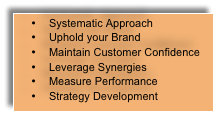CEO Blog - Advice for CEOs on growth and scaling
Building Company Value After an Acquisition

Marketing’s Role in Post-Merger Integration
The deal was just signed! Now what do we do? How many times have we heard this familiar cry? You are not alone. Over 70% of the deals completed today fail to add company value! The primary reason for most failures: poor post-merger integration planning and execution.
The integration of two businesses after an acquisition is no longer restricted to the domain of Finance and IT. Markets drive our businesses today! The role of Marketing in building company value after an acquisition is more critical than ever before.

To build market share, competitive dominance and product superiority, Marketing’s approach to the integration program must be very systematic. Marketing must uphold the brand, maintain customer confidence and leverage all possible synergies while vigilantly monitoring ROI. As if this isn’t a difficult enough balancing act, Marketing must articulate the longer-term “go-to-market” strategy to ensure the continuity of value enhancement programs long after the integration process is complete. So where do you begin?
Systematic Approach
Integrating the marketing activities of two businesses starts well before the transaction has been finalized. A team from Marketing should be actively engaged in the Due Diligence process making a thorough assessment of the target company’s products, market position, brand, customers, distribution, pricing, profitability, promotional strategies, sales channels, partnerships, etc. The primary value of any business resides in these assets and the Marketing team knows them best. Furthermore, the intellectual capital gained during Due Diligence should serve to be the foundation of the preliminary integration plan.
To assure all marketing assets from both companies are fully optimized, the same pre-deal Marketing team should be expanded to include colleagues from the newly acquired business.

Within the first week after the deal closes, the new Marketing team should transition the Pre-Plan into a working Action Plan. The team needs to 1) review the Pre-Plan objectives for a reality check, 2) assign personal accountability to each integration activity, 3) establish time-lines and 4) confirm financial targets. Whether meeting face-to-face or virtually, the Marketing integration team should collaborate weekly to review status and report on progress. By maintaining this regiment, all team members will know what is expected of them and be held accountable for their specific actions. Furthermore, complete program transparency within the team and with management will assure proper resource allocation to eachintegration activity.
For the complete paper on this subject, just visit this page and we’ll send it right out to you.
Topics: Corporate Strategy, CEO Strategies, Marketing Strategy, CEO Marketing Vision, Mergers & Acquisitions
Sun, Mar 27, 2011Related Articles

- Press Releases
- Careers
- Case Studies
- Marketing Consultant Company
- Marketing Strategy Consultants
- Marketing Plan Consultants
- B2B Marketing Consultants
- Virtual CMO
- Marketing Consultant Outsourcing
- Fractional CMO
- What is a Fractional CMO
- Healthcare Marketing Consultant
- Marketing Consultant Houston TX Texas
- Marketing Consultant Texas TX
- Marketing Consultant Bay Area
- CEO Blog
- Ebooks Plus
- Executive Marketing Consultants
- Product Marketing Consultants
- B2C Marketing Consultants
- Virtual Marketing Consultants
- Senior Marketing Consultants
- Temporary CMO
- Hire a CMO
- Fractional CMO Salary
- Fractional CMO Responsibilities
- Marketing Consultant Austin TX Texas
- Marketing Consultant Dallas TX Texas
- Marketing Consultant San Antonio
- Helping Private Equity
- Private Equity Blog
- Leadership Team
- Privacy Policy
- Business Marketing Consultants
- Strategic Marketing Consultants
- Marketing Technology Consultants
- Sales and Marketing Consultants
- CMO Job Description
- CMO Salary
- Fractional CMO Agency
- Fractional CMO Services
- CPG Marketing Consultant
- Marketing Consultant San Diego
- Partners
Houston, TX 77056
© 2023 Chief Outsiders

